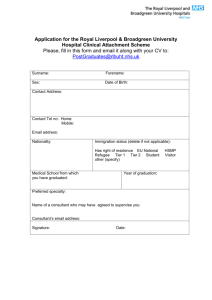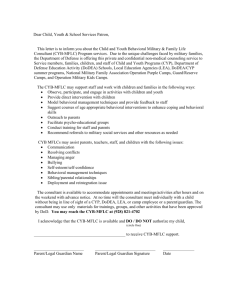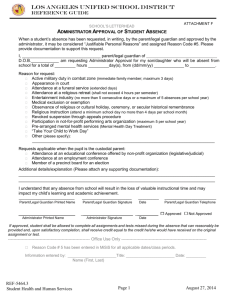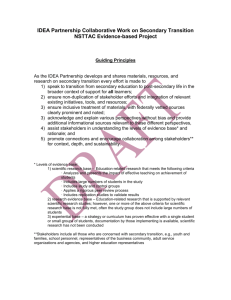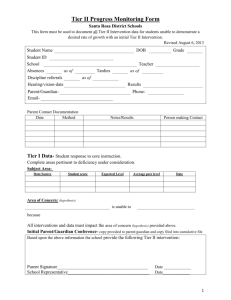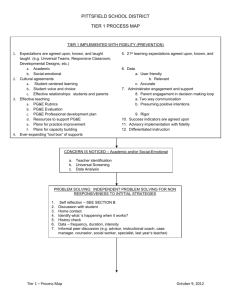The 14 Step Problem Solving Team Process
advertisement
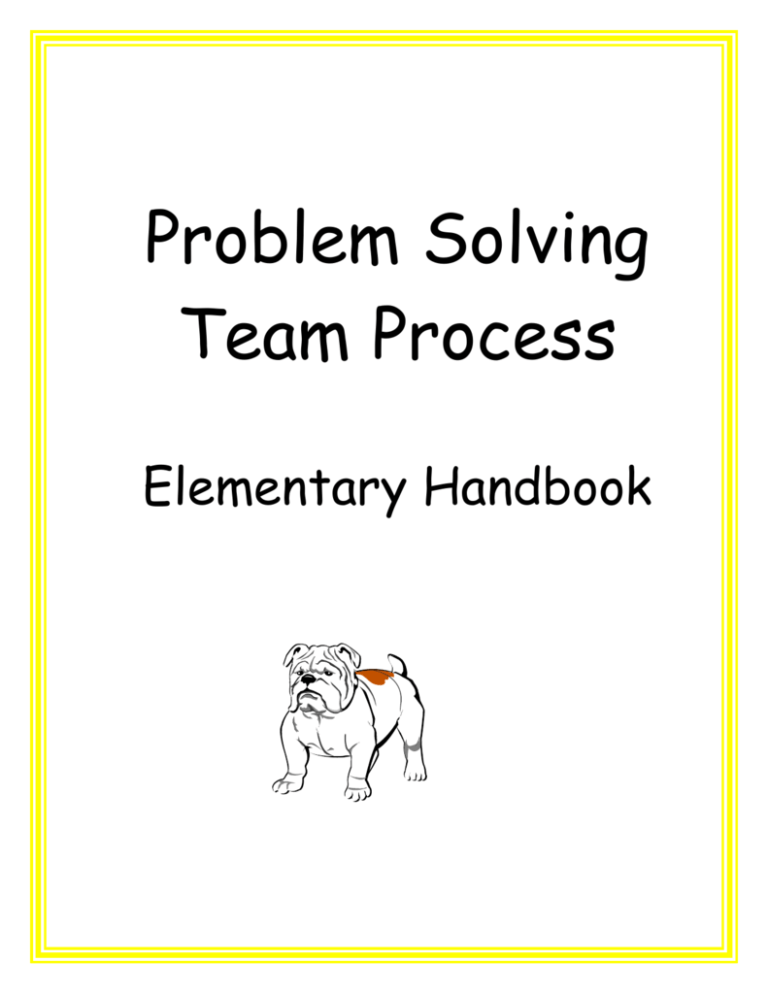
Problem Solving Team Process Elementary Handbook Table of Contents 1. Introduction 2. Section 1: Overview of the Problem Solving Team Process a. The 14 Step Problem Solving Team Process b. The Problem Solving Team Process Flowchart 3. Section 2: Request for Parent/Guardian Information Form 4. Section 3: Peer Consultant Checklist 5. Section 4: Student Data Form 6. Section 5: Developing an Intervention Plan a. Student Intervention Planning Form b. Intervention Intensity Rating Form 7. Section 6: Implementing an Intervention a. Intervention Fidelity Evaluation and Reflection b. Progress Monitoring 8. Appendices a. Administrator Cheat Sheet b. RtI Glossary of Terms c. Scantron Placement Indicators Introduction: Ongoing Problem Solving with Academic and Behavioral Concerns: Assistance to all Students Problem Solving is a way of examining all issues with all students, whether the concerns are behavioral or academic. The focus of Problem Solving should be on developing meaningful, measurable, and monitorable interventions for all students with needs, which are significantly discrepant from their average peers. Problem Solving essentially occurs on three levels. At the first level involves the teacher having a concern about a student. The focus at the first level is on the teacher gathering data, which would help define the student’s problem in a measurable, focused manner. This may involve: examining available information from the school cumulative file, talking to parents, consulting with other teachers, documenting any other interventions used with the student, under what conditions, and any results, observing the student, permanent products (along with average peer comparisons), short observations of the students behaviors as compared to peers, and the student’s performance on assessments such as District Wide Assessments, end of the chapter/unit tests, DIBELS, Curriculum Based Measurement reading, math, and written language probes, Individual Reading Inventories (if available), any measurable products from Title One Reading (if appropriate). These are only a few examples of measurable data. Behavioral Data could consist of noting how many times over a given week is the student talking out of turn, out of seat, using inappropriate language, fighting on the playground, is noncompliant with teacher directions, etc. Observations over short (20-30) minutes could help provide this information as well. Another adult such as the school psychologist could do the observations, with parent consent. ***** It is important to keep in mind at this first level; being able to define the student’s concern/problem is the key. The teachers need to be able to provide a BASELINE of what the student is doing that is the main issue to focus on. For example if the student is having difficulties learning to read, how so? Is the student significantly lower than average peers’ oral reading fluency? Or, is the student a good oral reader but unable to adequately complete assignments, and performs lower than peers on classroom and district wide assessments? Two different reading concerns, which would require different means of examining the available data and defining the problem in a measurable way. This is why the data a teacher gathers is so important. Often as educators we all have good intentions, but these intentions get lost if we cannot figure out as a team what it is we should all be focusing on with a student. In order to get to this point a teacher needs to bring enough quality data to a Problem Solving meeting so everyone involved understands the student’s problem/concern. This level of “enough quality data” is the BASELINE. It is important educators understand the differences between an Intervention, Accommodations, and Modifications. An Intervention involves teaching a new skill or strategy to a student on a short-term basis, monitoring frequently, with data collected to see if the intervention is successful. For example, if the student was having difficulty understanding simple math functions as compared to the average peers in the class, the teacher may, after gathering Baseline data, teach the student Touch Math, and then monitor the student’s progress over the next several weeks. If the student is not improving after a couple of weeks the teacher could change the strategy but still keep the focus or goal on increasing the student’s skills in completing simple addition and subtraction facts. If the student starts out with a Baseline of 6 addition facts in two minutes, and 2 subtraction facts in two minutes, and peer averages for the class is 15 addition facts and 12 subtraction facts in two minutes, a goal for an Intervention Plan could be as simple as “In six weeks, Johnny will solve simple addition problems at a rate of 10 problems correct in two minutes”. Accommodations involve making adaptations based on the student’s needs. For example, if the student is highly distractible and it is difficult for the student to focus during a test or a content area reading time, a study carrel in the general education setting would be an Accommodation. Reading tests to students with reading comprehension needs, and allowing a student to dictate written assignments are other classic examples of Accommodations. Modifications are simply adjustments in the curriculum, made for individual students based on the individual’s strengths and weaknesses as a learner as compared to the average of the class. Modifications allow students to participate in their Least Restrictive Environment. How are modifications different than Accommodations? For instance, the above example of allowing tests to be read aloud to a student with reading comprehension needs is an Accommodation because the student’s ability to read and understand information is within at least the average range of the class if he/she is given the Accommodation of having the test read to him/her. A Modification on the otherhand, involves modifying assignments for those students who demonstrate significant discrepancies (as compared to average classroom peers) in a skill area. For example, a student with significant skill discrepancies in written language may be allowed to write a one-sentence response rather than a paragraph, on a daily assignment. If the disability is in reading, using materials at the student’s Instructional reading level may help the student participate in Science and Social Studies classes within the General Education setting. Teamwork between both General and Special education teachers is a must. Students with disabilities have a legal and ethical right to accommodations and modifications. The main idea is to examine as a team of educators what are the main concepts the student needs to learn in Social Studies, for example? What are the standards to be met? Meeting the standards does not necessarily mean the student must use the same textbook, write the same reports, and complete the assignments as everyone else. If the student has a disability, which entitles him/her eligible to receive Special Education assistance in the area of need, or if a student has a disability that falls under Section 504, Accommodations and Modifications in the General Education setting are guaranteed to these students by law. Section 1: Overview of the Problem Solving Team Process Problems Solving Teams: Are a function of regular education. Use a systematic problem solving approach to assist students who are not progressing at a satisfactory rate. Clarify problems and concerns. Develop strategies and organize resources. Provide a system for accountability. Purpose: The problem solving team intervention model attempts to implement interventions before an initial referral is made to try to modify either the classroom setting or the child’s behaviors, or in some cases both. It includes setting a performance goal, selecting an intervention, monitoring student progress, and evaluating outcomes. The problem solving team model also provides educators with additional information about the child’s learning style, learning environment and classroom behaviors (Bahr & Kovaleski, 2006). The purpose of the Problem Solving Team process is to: Assist students who are not experiencing success in the classroom. Promote divergent thinking and problem-solving. Find solutions for children that are least restrictive. Provide support to teachers dealing with hard-to-teach students. The steps in the process (The 14 Step Problem Solving Team Process) and a flowchart (The Problem Solving Team Process Flowchart) are provided on two separate documents to organize the structure of the Problem Solving Team Process. (1 page each) The 14 Step Problem Solving Team Process 1. Parent/Guardian Involvement: (How and when will parents be involved) Documented phone call or in person contact notifying parent/guardian that there is a concern prior to initiating the PST process. Gather parent/guardian planning information using Request for Parent/Guardian Information form sent home or phone call 2. Sign-up with the building administrator to initiate the PST process and a Peer Consultant(s) is assigned. 3. Teacher completes Elementary Student Data Form and review the returned Request for Parent/Guardian Information form with peer consultant, as needed. 4. Peer consultant and teacher(s) meet to develop an intervention plan using Student Intervention Planning Form. 5. Provide a copy of the Student Intervention Planning Form to the student’s parent/guardian and the school administrator as well as any other school personnel responsible for implementing the plan. 6. Implement intervention plan and student progress monitoring for a minimum of 4 to 6 weeks. 7. Continuous collaborative meeting between teacher and peer consultant to review data and fidelity checks bi-weekly (Intervention Fidelity Evaluation and Reflection is completed a minimum of 1 time per week by teacher). 8. After 4 to 6 weeks of implementation, follow up with collaborative meeting including the teacher, peer consultant, administrator and parent/guardian to: Review data gathered Discuss progress, if any Determine if additional intervention is needed 9. If additional collaboration is needed, the team will determine additional team members and notify them of the Problem Solving Team meeting. 10. Tier 2 intervention plan will be developed with the team using the Student Intervention Planning Form and a copy of Student Intervention Planning Form is given to parent/guardian, teacher, administrator and any other teachers who need to be aware of the intervention plan. 11. Implement intervention plan and student progress monitoring for a minimum of 4 to 6 weeks. 12. Continuous collaborative meeting between teacher and peer consultant to review data and fidelity checks bi-weekly (Intervention Fidelity Evaluation and Reflection is completed a minimum of 1 time per week by teacher). 13. After 4 to 6 weeks of implementation, follow up with collaborative meeting including the teacher, peer consultant, administrator and parent/guardian to: Review data gathered Discuss progress, if any Determine if additional intervention is needed 14. Reconvene and review data. Determine if data that the student is regressing or not making progress, consider the need for a comprehensive evaluation. All forms are available at http://www.newlondon.k12.wi.us/pst.cfm The Problem Solving Team Process Flowchart Universal Screening for all students Rigby Running Records DRA Scantron Review data and identify students who meet grade level benchmarks. Tier 1 Students who meet benchmarks will remain at Tier 1. Performance will be reviewed at the next benchmark assessment. Tier 2 Students who do NOT meet benchmark standards will be considered for Tier 2 intervention. 1. Parent contact made by teacher regarding student concern(s). (Teacher can mean classroom teacher, specialist, counselor, school psychologist, nurse, principal, etc.) 2. Parent/guardian data collected using the Request for Parent/Guardian Information Form via phone call or mailing home. Teacher contacts administrator to initiate the Problem Solving Team process and a Peer Consultant(s) is assigned. Initial collaborative meeting (teacher and peer consultant(s)) Complete Student Data Form by reviewing previous data (including progress and behavior files, and Request for Parent/Guardian Information Form) Create academic intervention or behavior modification plan using Student Intervention Planning Form & Intervention Intensity Rating Form) A copy of the Student Intervention Plan is provided to the student’s parent/guardian and the school administrator, as well as any other school personnel responsible for implementing the plan. Intervention implemented (minimum of 4-6 weeks) Intervention Fidelity Evaluation and Reflection is completed a minimum of 1 time per week by teacher Continuous collaboration with peer consultant(s) bi-weekly Continue to provide updates to parents (***keep parent involved) Bi-weekly collaborative meetings (teacher and peer consultant(s)) Review data gathered & discuss progress, if any Determine if additional intervention is needed Determine need for additional team members & notify them of a follow-up meeting, as appropriate After 4-6 weeks of implementation, meet as a team with teacher, peer consultant(s), administrator and parent/guardian. Goal Met: Return to Tier 1 Making progress: Continue with intervention Insufficient progress: Develop a Tier 2 or Tier 3 intervention plan as appropriate Tier 3 Once the Tier 3 goal is met, return to Tier 1 or Tier 2 intervention, as determined by the team. If data shows that the student is regressing or not making progress, consider the need for a comprehensive evaluation. Note: SLD eligibility requirements include: Documentation of 12 weeks of intervention A minimum of 4 progress monitoring data points Documentation showing progress monitoring results were shared with parent/guardian Section 2: Request for Parent/Guardian Information Form: Purpose: The Request for Parent/Guardian Information Form is used to gather information from parents/guardians and involve them in the process. The form can be used as a discussion guide when parents attend a meeting with you to discuss concerns. (3 pages) Who completes: The form can be completed (1) by mailing home, (2) over the phone, or (3) in person with the parent/guardian. It is sent or completed with parent/guardian by the teacher or other school personnel and then reviewed during the initial collaborative meeting. Where is it kept: Upon completion it is kept in the yellow folder with the classroom teacher. Request for Parent/Guardian Information Problem Solving Team Parent/Guardian: Date: Student: Dear Parent/Guardian, Concerns with your child’s academic and/or behavior progress have been noted by . To address the academic/behavior needs of our students, our school has a designated Problem Solving Team. The purpose of the Problem Solving Team is to design effective interventions to help students learn and develop successfully in school. Since you know your child better than anyone else does, please take some time to think about what you know about your child and how that information may help the Problem Solving Team determine what may be done to help him or her. The Problem Solving Team respects confidentiality and is requesting that you only share information that will contribute to developing an effective Student Intervention Plan for your child. Please complete this form and return to by . 1. What do you see as your child’s strengths? _______________________________________________ ____________________________________________________________________________________ ____________________________________________________________________________________ ____________________________________________________________________________________ 2. In what area(s) could your child use the most improvement? What things does he/she seem to struggle with most? __________________________________________________________________ ____________________________________________________________________________________ ____________________________________________________________________________________ ____________________________________________________________________________________ 3. If we only targeted one area for improvement at a time, what do you see as the priority for your child? _____________________________________________________________________________ ____________________________________________________________________________________ ____________________________________________________________________________________ ____________________________________________________________________________________ 4. When you think about things your child needs to improve, what could be possible causes that we could change in order to make things better? Think about the following areas: a. Curriculum (Ex: Reading materials are too difficult or too easy to read; homework practice is inadequate for understanding or is based on material your child already knows.) _____________________ _________________________________________________________________________________ b. Instruction (Ex: Your child doesn’t understand what the teacher is teaching especially during whole class instruction.) ______________________________________________________________________ _________________________________________________________________________________ c. Environment (Ex: Noise distracts your child’s attention. A recent family event has been difficult for your child.) ___________________________________________________________________________ _________________________________________________________________________________ d. Learner (Ex: Your child lacks organization or study skills. Your child has not yet mastered behavioral skills.) _______________________________________________________________________________ _________________________________________________________________________________ 5. What can be done to address the areas of difficulty for you child? ____________________________ ____________________________________________________________________________________ ____________________________________________________________________________________ ____________________________________________________________________________________ 6. Additional information you feel is important for school staff to know about your child: ____________________________________________________________________________________ ____________________________________________________________________________________ ____________________________________________________________________________________ ____________________________________________________________________________________ What is the best way to contact you to follow up? Phone: ___________________________________________________________________ E-mail address: ____________________________________________________________ Times/days to reach you: _____________________________________________________ Times/days you are available to meet: ____________________________________________ Thank you for your input. If you have questions or would like to meet with someone prior to the scheduled Problem Solving Team meeting, please contact at . Section 3: The Peer Consultant Checklist Purpose: The peer consultant is defined as the primary colleague and support throughout the problem solving process. The peer consultant is assigned by the school administrator and is documented on the yellow folder. The yellow folder is given to the peer consultant with paperwork for the process, including the Peer Consultant Checklist. The Peer Consultant Checklist is used by the peer consultant at the initial meeting and each subsequent meeting to guide discussion at each meeting. It provides a simple reminder of the role of the peer consultant when working with the classroom teacher (1 page) Who completes: This form is completed by the peer consultant during the bi-weekly meetings. Where is it kept: This form is retained by the peer consultant. Peer Consultant Checklist Student’s Name: _____________________ Teacher’s Name: ____________________ Grade: ______ As soon as you are assigned as the Peer Consultant to a student’s case, you are the primary colleague and support throughout the process. This includes the responsibilities outlined in this checklist. Receive a yellow folder from your building’s administrator. Date of Assignment: _______________ Initial Meeting: Meet with the student’s teacher as soon as possible (plan on meeting for approximately 30 min. - 1 hour). Date of Meeting: ______________ Review the information from the Request for Parent/Guardian Information form. Complete or review the Student Data Form. Develop an intervention plan and document using the Student Intervention Planning Form. (Use the Intervention Intensity Rating Form to assist with determining the Tier Intensity). Important things to remember: a. How and when will baseline data be collected (if not already available)? b. When will the intervention begin? c. Once the intervention has started, how will process be monitored and how often? d. What resources are needed in order to apply this intervention? e. Who will finalize Student Intervention Planning Form and distribute to the student’s parent/guardian, school administrator and all other school personnel who will be involved with the intervention process? Schedule follow-up meeting with the teacher for approximately two weeks after the intervention has been started. Date of next meeting: ___________________ Follow-up Meetings: (plan for about 30 minutes every other week, record meeting dates on the Intervention Planning form) Date: _____ _____ _____ Review Intervention Fidelity Evaluation and Reflection form. Review progress monitoring data and document progress and any changes on the Student Intervention Planning Form. Adjust intervention as needed. (A consistent intervention must be implemented for 4-6 weeks. If the intervention is modified or changed at this point, the intervention timeline starts over). Date of next meeting: _______________, _______________, ______________ Final Steps: After 4-6 weeks of intervention implementation, meet with the teacher, school administrator and parent/guardian to: Review data Discuss progress Determine the effectiveness of the intervention Determine next steps: continue current intervention choose a different intervention (consider your brainstormed list on the Student Intervention Planning Form) schedule a meeting with other school personnel for further planning. Section 4: Student Data Form Purpose: The Student Data Form is used to collect the preexisting data on a student. It includes background, academic, and behavioral information. It is documentation of what has previously been tried with a student and the outcome. It also provides a space for desired outcomes, which will assist with writing appropriate goals and the intervention plan for the student. (5 pages) Who completes: Option 1-The form is completed by the classroom teacher prior to the initial meeting with the peer consultant. Option 2 – The form is completed with the peer consultant during the initial meeting. During the initial meeting you will need the following information or access to the following information: Information from the student’s progress file Information from the student’s behavior file Data from district and statewide testing Data from classroom assessments Teacher observations Previous interventions and results of the interventions Baseline data for problem behavior(s), if available Where is it kept: Upon completion, the Student Data Form is kept in the yellow folder with the classroom teacher. School District of New London Student Data Form CONFIDENTIAL Staff Name: Date: STUDENT INFORMATION Student Name: Grade: Teacher: Date of Birth: Parent/Guardian: Home Phone: Cell Phone: Address: Work Phone: Strengths: Concerns: (prioritize your concerns) Attendance: (if applicable) Medical Information: Medical information is currently impacting student learning. Medical information is not impacting student learning. Other Pertinent Information: Age: COMMUNICATION Contacts Information Obtained/ Results/ Outcomes Review the student’s progress file and behavior file, including standardized testing, assessments, programming, and interventions Consult with student’s former teacher (s) Consult with other teachers (special education, Title I, music, art, physical education, school counselor) Discussion with student regarding specific concerns (behavior, attendance, achievement) Contact parents regarding concerns Method Date Method Date CURRENT ACADEMIC INFORMATION (completed by the classroom teacher) Academics Performance RIGBY Level Date: Level Date: Level Date: Level Date: Level Date: Level Date: Level Date: Level Date: DRA Dolch Sight Words (K-3) List Support Needed (i.e., 1:1, modified curriculum) A B D C E Scantron Range Grade 2 Winter Spring Reading Grade 3 Fall Winter Spring Grade 4 Fall Winter Spring Grade 5 Fall Winter Spring Grade 6 Fall Winter Spring Academics WKCE 3rd grade M=minimal performance B=basic P=proficient A=advanced WKCE 4th grade Performance Reading Math Support Needed (i.e., 1:1, modified curriculum) M M B B P P A A Reading Math Language Social Studies Science M M M M M B B B B B P P P P P Reading Math M M B B P P A A Reading Math M M B B P P A A WKCE 5th grade WKCE 6th grade Theme Test Theme 1 / Theme 2 / Theme 3 / Theme 4 / Theme 5 / Theme 6 / Literacy Screener Writing Emergent Writing Rubric Score Fine Motor Ideas and Content Organization Voice Word Choice Sentence Fluency Conventions Math A A A A A Scantron Range Grade 2 Winter Spring Math Grade 3 Fall Winter Spring Grade 4 Fall Winter Spring Grade 5 Fall Winter Spring Grade 6 Fall Winter Spring STRENGTHS AND CONCERNS Behaviors Strength Concern Prioritize Concerns Comments/Explanation Shows courtesy and respect to teachers Shows self-discipline (impulsive / restless) Accepts responsibility for own actions Stays on task (distractible/short attention span) Respects rights / property of others. Follows directions Works independently Completes assignments on time Comes to class prepared Uses good organizational habits Completes work neatly Frustration tolerance Social relationships Other: Attach the following documents: Office Referral Forms Behavior Intervention Plan Behavior Related Concerns (Complete this section only if behavior is the main area of concern) List Primary Behavior Concern: When have you observed the behavior occurring the most? Are there specific settings or situations in which the behavior is less severe or minimized? If so, when? What generally occurs as a result, following the behavior (consequences)? Are there social consequences / concerns as a result of this behavior? If so, please describe. Describe any interventions used within the classroom/school setting to address the student’s needs and the results of interventions (include data). 1. 2. 3. State as a measurable goal your desired outcome for the student. 1. 2. 3. Identify your primary goal for this student and transfer that goal to the Student Intervention Planning Form. Section 5: Developing an Intervention Plan Purpose: To develop an intervention plan using the Student Intervention Planning Form. (Use the Intervention Intensity Rating Form to assist with determining the tier intensity). Student Intervention Planning Form: This is the form used to outline the intervention that will be done with the student. Intervention resources should be available to complete this form such as the Intervention binder, books or access to a computer to use intervention websites. Details of the intervention and how progress will be monitored are outlined. This form is also used for follow-up consultation meetings to review the data that has been collected. (3 pages) Intervention Intensity Rating Form: This is a checklist to help teachers determine the Tier the intervention plan they are creating for a specific student or a specific group of students is at. (3 pages) Who completes: These forms are completed during the initial meeting with the peer consultant and teacher, provided that baseline data on the targeted area has been collected. If additional data is needed to create the baseline, a second meeting should be scheduled to complete the Student Intervention Planning Form. Where is it kept: Upon completion, these forms are kept in the yellow folder with the classroom teacher. The Student Intervention Planning Form is used to document data at the bi-weekly meetings. Student Intervention Planning Form Student Name: Tier Intensity: Date: Tier 1 Tier 2 Tier 3 Teacher: (Complete Intervention Intensity Rating Form to determine) Explore Options Desired Goal Write a measurable goal (use desired outcomes identified on Student Data Form). Include behavior, time frame and criterion. Example: Tommy will increase his RIGBY reading level from level 12 to level 22 by May. Susie will master Dolch Sight Word Lists C, D, and E by June. Brainstorm intervention methods (refer to intervention binder, interventioncentral.org, etc) Brainstorm to generate intervention methods. Evaluate each one and record the top five. Place an asterisk (*) by the intervention method selected to implement and attach copy, as appropriate. 1. 2. 3. 4. 5. Design the Plan Identify the setting where implementation will occur: general education setting combination of settings: other: Intervention Considerations: Record details of the intervention plan. When will the intervention start? When will the intervention take place? (Specify days and times) Who will be responsible for carrying out this intervention plan? What (if any) special instructional or behavioral program materials/resources or training is needed for this intervention? (Please specify) Intervention Fidelity Evaluation and Reflection form to be completed at least weekly. How acceptable is the intervention to the classroom teacher? Low 1 2 3 4 5 High (circle) Monitoring the Intervention: Progress Monitoring: Beginning date: Direction of Change: Measurement Strategy: Increase Review date: Decrease Maintain Who is responsible for doing the actual data collection? Method of data collection: Frequency of data collection: Baseline data: Copy of planning form is given to parent and administrator. Review the Data Week 2 Date: Is the intervention being implemented as designed at the initial meeting? If not, why? Yes No Are there additional supports/resources that are needed? Is the frequency of the intervention implementation being recorded? Do you feel the intervention is effective? Progress: Yes Yes No No Has there been progress? Baseline data: Current data: Notes: Next meeting date: If there are unresolved issues, please follow-up with administrator. Week 4 Date: Is the intervention being implemented as designed at the initial meeting? If not, why? Yes Are there additional supports/resources that are needed? Is the frequency of the intervention implementation being recorded? Do you feel the intervention is effective? Progress: Yes Yes No Has there been progress? Baseline data: Current data: Notes: Next meeting date: If there are unresolved issues, please follow-up with administrator. No No Week 6 Date: Is the intervention being implemented as designed at the initial meeting? If not, why? Yes No Are there additional supports/resources that are needed? Is the frequency of the intervention implementation being recorded? Do you feel the intervention is effective? Progress: Yes Yes No No Has there been progress? Baseline data: Current data: Notes: Next meeting date: If there are unresolved issues, please follow-up with administrator. Final Meeting Date: Goal met or exceeded Goal not met but performance improved Goal not met and performance did not improve or got worse *Attach data sheets and graphs. Determine next steps: continue current intervention choose a different intervention (consider your brainstormed list on the Student Intervention Planning Form) schedule a meeting with other school personnel for further planning Additional Information, Comments or Concerns: Intervention Intensity Rating Form New London School District Teacher name: Date: Intervention Title/Description: Check or circle the appropriate column, if hesitant, choose the higher of the two columns. PREPARATION 1. Preparation for the Intervention: certification or other formal credentials required to qualify person to implement the intervention 2. On a per-pupil basis, the cost to purchase or effort needed to create the intervention materials 3. Initial Training required to use the intervention IMPLEMENTATION 4. Amount of preparation required for each session of the intervention 5. Average time needed each session to implement the intervention 6. Degree to which the intervention is tailored to the unique needs of the target student 7. Degree to which the intervention can be carried out by the educator as part of his or her ‘typical’ instructional routine Column 1 No certification or specialized credentials required Column 2 Certification or specialized credentials required, but commonly available at school Column 3 Certification or specialized credentials required Intervention materials not needed or do not entail significant expense or effort Intervention materials required, at a modest cost or with reasonable effort Intervention materials per pupil are costly or require substantial effort to create Little or no training needed Modest training needed(12 sessions) Significant training required (more than 2 sessions) Little or no preparation is needed Some preparation needed (15 minutes per session) Little or no extra time is needed Some time is needed (up to 30 minutes per session) Intervention is likely to be effective with a wide range of students (e.g. use praise statements) Intervention is tailored to the target students but could also be applied to other students who show similar, somewhat common problems Intervention requires that the educator expend moderate amount of additional effort or time beyond the usual instructional routine Substantial preparation is needed (more than 15 minutes per session) Substantial preparation needed (more than 30 minutes per session) Intervention is highly individualized to the needs of the target student and unlikely to be applicable to many other students in the class or school Intervention requires that the educator expend significant additional effort or time beyond the usual instructional routine Intervention can be fully integrated into the teacher’s instructional routine. 8. Size of the developmental gap between the stated intervention outcome goal(s) of the target student and the ‘typical’ academic or behavioral levels of the classroom or grade level 9. Potential of the intervention to distract other students or disrupt the learning of others MONITORING OF THE INTERVENTION 10. Effort required to monitor the success of the intervention TOTALS Count the number of responses in each column. Intervention goal approaches or matches the academic or behavioral levels of most students in the classroom or grade level Intervention goal falls below the academic or behavioral levels of most students in the classroom or grade level Intervention goal falls significantly below the academic or behavioral levels of most students in the classroom or grade level Intervention can be implemented with little or no disruption to students or learning Intervention is likely to result in mild distraction of students or mild disruption to student learning Intervention is likely to result in significant distraction of students or significant disruption to student learning Monitoring requires little additional effort (e.g. a teacher who rates a student on a Daily Behavior Report Card) Column Total Monitoring requires moderate additional effort Monitoring requires significant additional effort (e.g. a psychologist who carries out twice-weekly direct observations) Column Total Column Total How to use: o If 7 or more of the 10 fall under any single tier it is likely that is the tier o If you have a mixed pattern of ratings, the intervention should be considered the intensity of the highest column containing at least 3 checks. Tier intensity determined to be _____________________________________________________________________ Section 6: Implementing an Intervention Purpose: Implement intervention plan and student progress monitoring for a minimum of 4 to 6 weeks. Be sure to document the student’s progress and complete the Intervention Fidelity Evaluation and Reflection form. Intervention Fidelity Evaluation and Reflection: The fidelity in which an intervention is carried out can impact the intervention results. (Fidelity of implementation is defined as “how closely the prescribed procedures are followed.” (Mellard & Johnson, p.117, Chapter 8).) To ensure good intervention fidelity this form has been created for teachers to use on a weekly basis to reflect how closely they have adhered to the treatment protocol. This can then be reviewed with the peer consultant during bi-weekly meetings. (3 pages) Who completes: Completed by teacher(s) who are responsible for implementing the intervention. Where is it kept: Upon completion, this form is kept in the yellow folder with the classroom teacher. Intervention Fidelity Evaluation and Reflection Student _______________________ Date of Initial Plan Development:______________ Staff Member(s) Implementing Intervention: _______________________________________ Location: _______________________________ Intervention Description: _______________________________________________________ ______________________________________________________________________________ ______________________________________________________________________________ Complete the following below, rating ‘1’ as Not At All, ‘9’ as Fully. Date:_____________ Comments:____________________________________________ To what degree were you able to carry out the intervention as it was intended? 1 2 3 not at all 4 5 6 somewhat 7 8 9 fully If rating fell below a 7, describe reasons it could not be carried out as planned. ______________________________________________________________________________ ______________________________________________________________________________ ______________________________________________________________________________ Date:_____________ Comments:____________________________________________ To what degree were you able to carry out the intervention as it was intended? 1 2 3 not at all 4 5 6 somewhat 7 8 9 fully If rating fell below a 7, describe reasons it could not be carried out as planned. ______________________________________________________________________________ ______________________________________________________________________________ ______________________________________________________________________________ Date:_____________ Comments:____________________________________________ To what degree were you able to carry out the intervention as it was intended? 1 2 3 not at all 4 5 6 somewhat 7 8 9 fully If rating fell below a 7, describe reasons it could not be carried out as planned. ______________________________________________________________________________ ______________________________________________________________________________ ______________________________________________________________________________ Date:_____________ Comments:____________________________________________ To what degree were you able to carry out the intervention as it was intended? 1 2 3 not at all 4 5 6 somewhat 7 8 9 fully If rating fell below a 7, describe reasons it could not be carried out as planned. ______________________________________________________________________________ ______________________________________________________________________________ ______________________________________________________________________________ Date:_____________ Comments:____________________________________________ To what degree were you able to carry out the intervention as it was intended? 1 2 3 not at all 4 5 6 somewhat 7 8 9 fully If rating fell below a 7, describe reasons it could not be carried out as planned. ______________________________________________________________________________ ______________________________________________________________________________ ______________________________________________________________________________ Appendix A: Administrator Cheat Sheet Administrator Cheat Sheet 1st Yellow Folder Forms for the referring teacher: 1. Request for Parent/Guardian Information Form 2. Student Data Form 2nd Yellow Folder Forms for the assigned peer consultant 1. Peer Consultant Checklist Forms to be completed together during consultation meetings 1. Student Intervention Planning Form 2. Intervention Intensity Rating Form Appendix B: RtI Glossary of Terms Glossary of Terms for RtI Accommodation Change made to instruction and/or assessment that does not change the expectations for performance or change the construct that is being measured. Accommodations provide access to buildings, curriculum, and assessments. Adaptation An adjustment to the instructional content or performance expectations of students with disabilities from what is expected or taught to students in general education. Adaptations can include decreasing the number of exercises the student is expected to complete, assigning different reading materials, or allowing use of a calculator. Core Curriculum A course of study deemed critical and usually made mandatory for all students of a school or school system. Core curricula are often instituted at the primary and secondary levels by school boards, Departments of Education, or other administrative agencies charged with overseeing education. Core curricula must be scientific and research-based. Curriculum-Based Measurement (CBM) Tools for measuring student competency and progress in the basic skill areas of reading fluency, spelling, mathematics, and written language. Data Points Points on a graph that represent student achievement or behavior relative to a specific assessment at a specific time. Differentiated Instruction Process of designing lesson plans that meet the needs of the range of learners; such planning includes learning objectives, grouping practices, teaching methods, varied assignments, and varied materials chosen based on student skill levels, interest levels, and learning preferences; differentiated instruction focuses on instructional strategies, instructional groupings, and an array of materials. Early Intervening Services (EIS) Early intervening services are the preventive components of No Child Left Behind and the Individuals with Disabilities Education Act of 2004. From NCLB: An LEA will provide training to enable teachers to teach and address the needs of students with different learning styles, particularly students with disabilities, students with special learning needs (including students who are gifted and talented), and students with limited English proficiency; and to improve student behavior in the classroom and identify early and appropriate interventions to help these students. From IDEA: An LEA may use up to 15% of its IDEA Part B funds in any fiscal year, less any funds reduced from its local fiscal effort, to develop and implement coordinated, early intervening services. Coordinated early intervening services may include interagency financing structures (for students in K-12 with a particular emphasis on students in K-3) who have not been identified as needing special education or related services but who need additional academic and behavioral support to succeed in a general education environment. When it has been determined that there is significant disproportionality with respect to the identification of children as children with disabilities, or the placement in particular educational settings of such children, the SEA shall require the LEA to reserve the maximum 15% of IDEA Part B funds to provide comprehensive coordinated early intervening services to serve children in the LEA, particularly children in those groups that were significantly over-identified. EIS Activities could include: Professional development for teachers and other school staff to deliver scientificallybased academic instruction and behavioral interventions, including scientifically-based literacy instruction, and, where appropriate, instruction on the use of adaptive and instructional software; and providing educational and behavioral evaluations, services and supports, including scientifically-based literacy instruction. Fidelity of Implementation & Instruction Implementation of an intervention, program, or curriculum according to research findings and/or on developers’ specifications. GIST: General Intervention Support Team MISD RtI program Intensive Interventions Academic and/or behavioral interventions characterized by increased length, frequency, and duration of implementation for students who struggle significantly; often associated with narrowest tier of an RTI tiered model; also referred to as tertiary interventions. Learning Disability IDEA 2004 defines a Learning Disability/Specific Learning Disability in the following manner: The child does not achieve adequately for the child’s age or to meet Stateapproved grade-level standards in one or more of the following areas, when provided with learning experiences and instruction appropriate for the child’s age or stateapproved, grade-level standards. (i) Oral expression. (ii) Listening comprehension. (iii) Written expression. (iv) Basic reading skill. (v) Reading fluency skills. (vi) Reading comprehension. (vii) Mathematics calculation. (viii) Mathematics problem solving Over-Identification Refers to the over representation of students in special education programs/services that is above state and national averages; identification of more students for services through special education than the proportion of that population in the general population. Positive Behavior Support A tiered intervention system based on school-wide practices that encourage and reward positive student and adult behavior. Positive Behavior Supports Evidence-based practices embedded in the school curriculum/culture/expectations that have a prevention focus; teaching, practice, and demonstration of pro-social behaviors. Problem-Solving Team Group of education professionals coming together to consider student-specific data, brainstorm possible strategies/interventions, and develop a plan of action to address a student-specific need. Progress Monitoring A scientifically based practice used to assess students’ academic performance and evaluate the effectiveness of instruction. Progress monitoring can be implemented with individual students or an entire class. Also, the process used to monitor implementation of specific interventions. Response to Intervention (RTI) Practice of providing high-quality instruction and interventions matched to student need, monitoring progress frequently to make changes in instruction or goals, and applying child response data to important educational decisions. Scaffolding An instructional technique in which the teacher breaks a complex task into smaller tasks, models the desired learning strategy or task, provides support as students learn to do the task, and then gradually shifts responsibility to the students. In this manner, a teacher enables students to accomplish as much of a task as possible without adult assistance. Scientific, Research-Based instruction Curriculum and educational interventions that have been proven to be effective for most students based on scientific study. Scientifically Research Based Interventions Scientifically based research has the meaning given the term in section 9101(37) of the Elementary and Secondary Education Act (ESEA) of 1965. Section 9101(37) of ESEA, as amended by the NCLB, defines scientifically based research as “research that involves the application of rigorous, systematic, and objective procedures to obtain reliable and valid knowledge relevant to education activities and programs.” The statute then explains that this kind of research: (1) Employs systematic, empirical methods that draw on observation or experiment; (2) Involves rigorous data analyses that are adequate to test the stated hypotheses and justify the general conclusions drawn; (3) Relies on measurements or observational methods that provide reliable and valid data across evaluators and observers, across multiple measurements and observations, and across studies by the same or different investigators; (4) Is evaluated using experimental or quasi-experimental designs in which individuals, entities, programs, or activities are assigned to different conditions and with appropriate controls to evaluate the effects of the condition of interest, with a preference for random-assignment experiments, or other designs to the extent that those designs contain within-condition or across-condition controls; (5) Ensures that experimental studies are presented in sufficient detail and clarity to allow for replication or, at a minimum, offer the opportunity to build systematically on their findings; and (6) Has been accepted by a peer-reviewed journal or approved by a panel of independent experts through a comparably rigorous, objective, and scientific review. Tiered Instruction Levels of instructional intensity within a tiered model of service delivery. Tiered Model Common model of three or more tiers that delineate levels of instructional interventions based on student skill need. Universal Screening A process of reviewing student performance through formal and/or informal assessment measures to determine progress in relation to student benchmarks; related directly to student learning standards Taken from the RtI Action Network http://www.rtinetwork.org/ Appendix C: Scantron Placement Indicators
